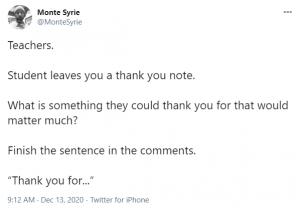TL;DR:
- For far too long, the scales of education tipped in favor of content over kids. It’s time we tip it back; relationships make the case for kids over content.
- Smiles and Frowns is an activity you can implement in your class to give each student a chance to share their voice every single day.
- During Smiles and Frowns, the teacher calls on every student every day. Every day students have an opportunity to share something that made them smile or frown.
In mid-December, educator Monte Syrie (@MonteSyrie) posed a question on Twitter:

Original Tweet from @MonteSyrie
Responses ranged from “writing recommendation letters” to “sharing your story,” but by the end of the month, most responses were some version of Thank you for caring about me.
Think back to your own experiences, to the teachers and classes you liked best. If you’re like me, what you remember most is how you felt, not necessarily what you learned. That isn’t to say you’ve forgotten everything or that content is never important. But consider how much easier it was to recall those positive experiences over ones that were not emotionally engaging.
Think back to your own experiences, to the teachers and classes you liked best. If you’re like me, what you remember most is how you felt, not necessarily what you learned. Share on XThe Relationship Conundrum
Twenty years into the 21st century and educators recognize the value of building relationships and establishing rapport. Though new teachers may still hear the advice about not smiling before Christmas, or not sharing their personal life, our experience in the real world shows that advice is not helpful in building relationships.
As teachers, we know that building a sense of community is the foundation for a good year. However, we may struggle translating that into practice, or we feel we just don’t have the time because there is so much to cover. Perhaps we try to set the stage by using icebreakers in the first few days of class. But after a week or so, it’s on to content, quickly, to prepare for the end-of-year tests.
In my building, our daily announcements end with the principal’s maxim: “Work hard, be nice, and widen your circle.” He reminds us daily that we are all in this together. Yet even in my building, most teachers treat a week with icebreakers or a few days of team-building activities as enough. Enough for students to know their classmates’ names. Enough for students to feel comfortable and valued in the classroom. Enough for students to have formed and to maintain relationships with one another and the teacher.
Relationships take an investment of time and energy. Yet we often don’t use the same tools for building relationships with our students as we do in our personal lives. Why do we simply check the box on forming relationships with students?
Kids Over Content: Building Relationships Every Day
In fall 2019, I began using Monte Syrie’s Smiles and Frowns. The premise is simple: the teacher calls on every student every day. Every day students have an opportunity to share something that made them smile or frown. At the same time, I made it the grounding exercise at my twice-a-week PLN meetings. My colleagues loved the focused opportunity to share—something we wanted to do anyway. And our relationships deepened as we no longer solely sought out friends and shared in small side conversations. We engaged as a whole group, which allowed us to celebrate and commiserate together.
My students enjoyed the opportunity to share as well, even if they decided simply to listen. There were days where the same students passed again and again. However, one of my favorite elements of Syrie’s structure is that every student, every day, hears their name and is invited to contribute.
In a regular class period, some students always volunteer and know their voices are valued. Some students are a source of frustration; their names are called as a classroom management measure. And some students slip through the cracks, going all school day without being called on for anything. Smiles and Frowns means that all students can see how everyone’s smiles and frowns—no matter how big or small—are important. This helps them see that they, too, are important.
Kids Over Content: Lessons Learned from COVID-19
My system started the 2020 school year virtually, and I was worried about how to introduce Smiles and Frowns when the kids would not be together. Additionally, the program my system used for synchronous lessons does not show all attendees, so there was no way we would be able to see everyone even in the virtual space. However, I didn’t let that stop me.
I knew that it would be critical during a pandemic to establish a community and create a safe digital environment. I kept the Smiles and Frowns, despite it taking longer as everyone unmuted to share or typed in the chat on their turn. There are days Smiles and Frowns go quickly and others where it can take up to fifteen minutes of our 80-minute class. Despite that, I am intentional about preserving time to allow all students a voice.
Some students volunteer each class. Others pass every day. But everyone benefits from the promise of the opportunity. When I surveyed my classes at the end of the first quarter, more than 90% said they felt safe in my class, that they felt cared about, and that they felt like they “belonged.” In sharing what they liked most about class, many referenced Smiles and Frowns and the ability it gave them to connect to one another. Similarly, another teacher in my PLN started using Smiles and Frowns with her classes and noted that many students respond positively to the chance to share how they are doing or feeling.
[scroll down to keep reading]Final Thoughts
While I’ve found great success with Smiles and Frowns, I know Syrie’s structure doesn’t work for everyone. It may feel forced or superficial. Teachers may have a different groove going on. But what I feel it does is provide my students a protected opportunity to connect. Despite how busy things get or what I may feel I need to cover, I never skip Smiles and Frowns. That daily investment in my students and their relationship with me and their classmates is more important than any content I can teach them.
Feeling valued in class means they are more likely to engage with the content. They may be more resilient in the face of challenges because they know I will be there to support them. It creates a rapport that could not exist on the foundation of those start-of-school icebreakers alone.
We know our content matters. We know relationships matter. For far too long, the scales of education tipped wildly in favor of content over kids. I think it’s time we tip it back.
Relationships make the case for kids over content.
About Megan Balduf
Megan Balduf is an English teacher with more than fifteen years’ experience at the middle school level. While being a classroom teacher had always been her dream, her reality allowed her to reach beyond the walls of her classroom. With the encouragement of administrators at her school in Fairfax, VA, Megan has grown through various leadership positions including mentor teacher and English department chair. As a model of lifelong learning, since entering the classroom, Megan has earned an MA in Gifted Education, an MA in English for Language Arts Teachers, and became a National Board Certified Teacher. In her spare time, she enjoys reading, running, and being Mom to her two children.



